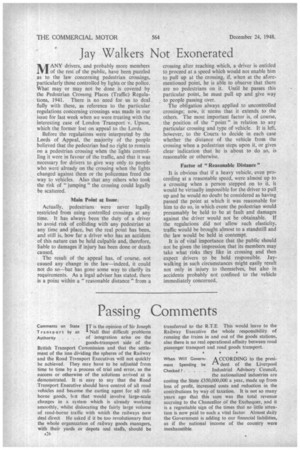Jay Walkers Not Exonerated
Page 28

If you've noticed an error in this article please click here to report it so we can fix it.
MANY drivers, and probably more members of the rest of the public, have been puzzled as to the law concerning pedestrian crossings, particularly those controlled by lights or the police. What may or may not be done is covered by the .Pedestrian Crossing Places (Traffic) Regulations, 1941. There is no need for us to deal.. fully with these, as reference to the particular regulations concerning crossings was made in our issue for last week when we were treating with the interesting case of London Transport v. Upson, which the former lost on appeal to the Lords.
Before the regulations were interpreted by the Lords of Appeal, the majority of the people believed that the pedestrian had no right to remain on a pedestrian crossing when the lights controlling it were in favour of the traffic, and that it was necessary for drivers to give way only to people who were already on the crossing when the lights changed against them or the policeman freed the way to vehicles. Also that any others who took the risk of " jumping " the crossing could legally be scattered.
Main Point at Issuel Actually, pedestrians were never legally restricted from using controlled crossings at any time. It has always been the duty of a driver to avoid risk of colliding with any pedestrian at any time and place, but the real point has been, and still is, how far a driver who has an accident of this nature can be held culpable and, therefore. liable to damages if injury has been done or death caused, The result of the appeal has, of course, not caused any change in the law—indeed, it could not do so—hut has gone some way to clarify its requirements. As a legal adviser has stated, there is a point within a "reasonable distance" from a crossing after reaching which, a driver is entitled to proceed at a speed which would not enable him to pull up at the crossing, if, when at the aforementioned point, he is able to observe that there are no pedestrians on it. Until he passes this particular point, he must pull up and give way to people passing over. The obligation always applied to uncontrolled crossings; now, it seems that it extends to the others. The most important factor is, of course, the position of the " point " in relation to any particular crossing and type of vehicle. It is left, however, to the Courts to decide in each case whether the distance of the vehicle from the crossing when a pedestrian steps upon it, or gives clear indication that he is about to do so, is reasonable or otherwise.
Factor of "Reasonable Distance" It is obvious that if a heavy vehicle, even proceeding at a reasonable speed, were almost up to a crossing when a person stepped on to it, it would be virtually impossible for the driver to pull, up and he would no doubt be considered as having passed the point at which it was reasonable for him to do so, in which event the pedestrian would presumably be held to be at fault and damages against the driver would not be obtainable. If the regulations did not allow such elasticity, traffic would be brought almost to a standstill and the law would be held in contempt.
It is of vital importance that the public should not be given the impression that its members may take what risks they like in crossing and then expect drivers to be held responsible. Jaywalking in such circumstances might easily result not only in injury to themselves, but also in accidents probably not confined to the vehicle immediately concerned..




















































































